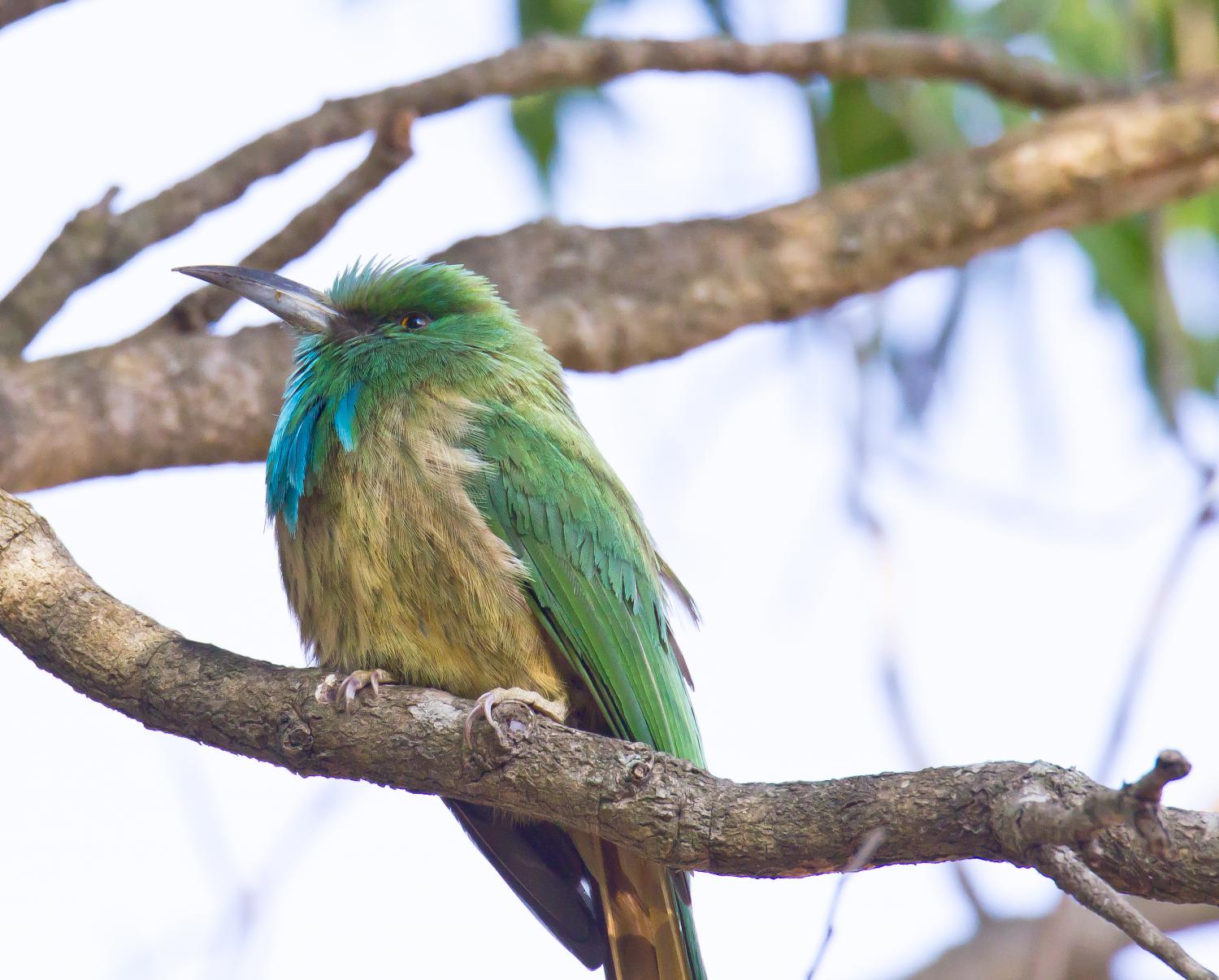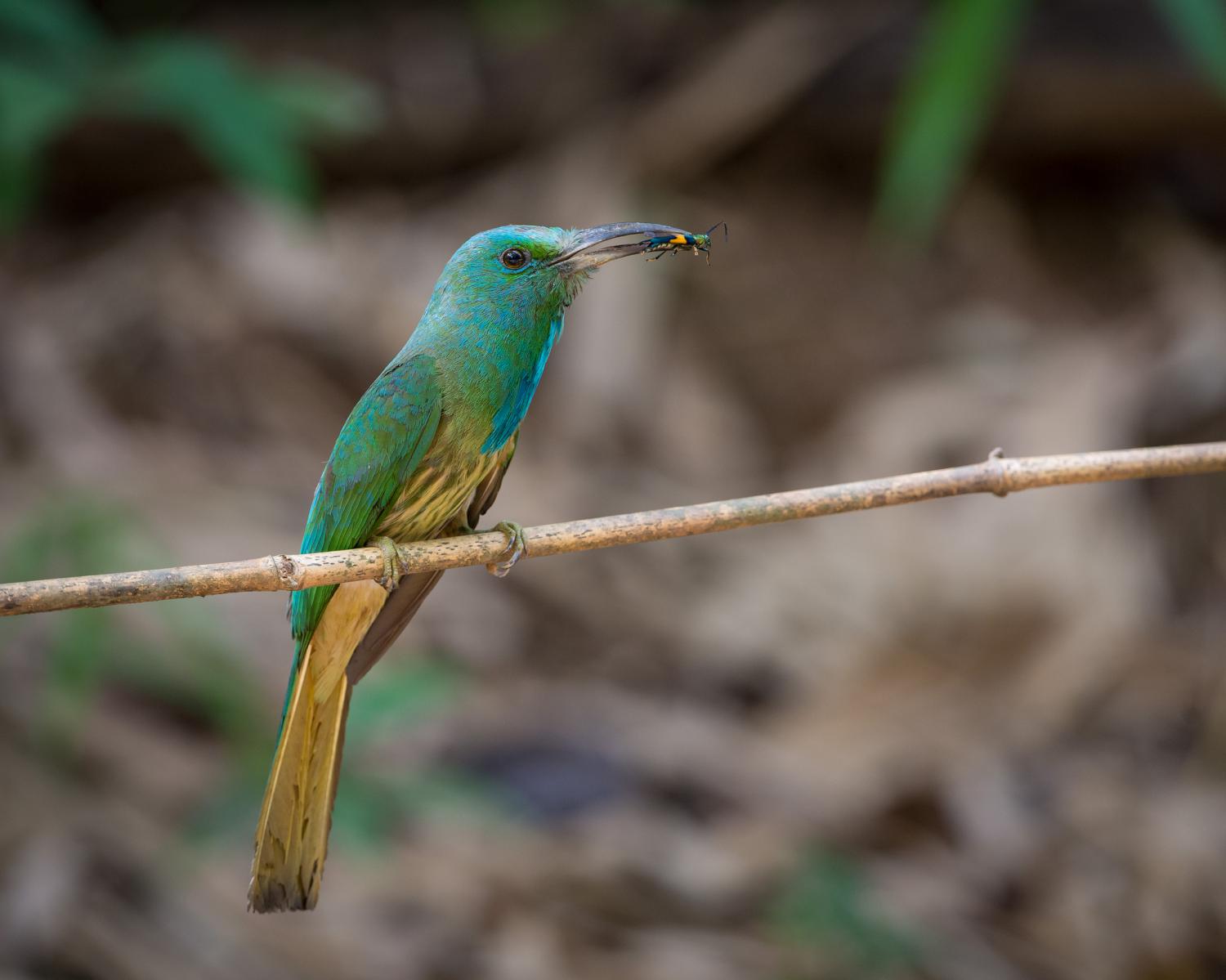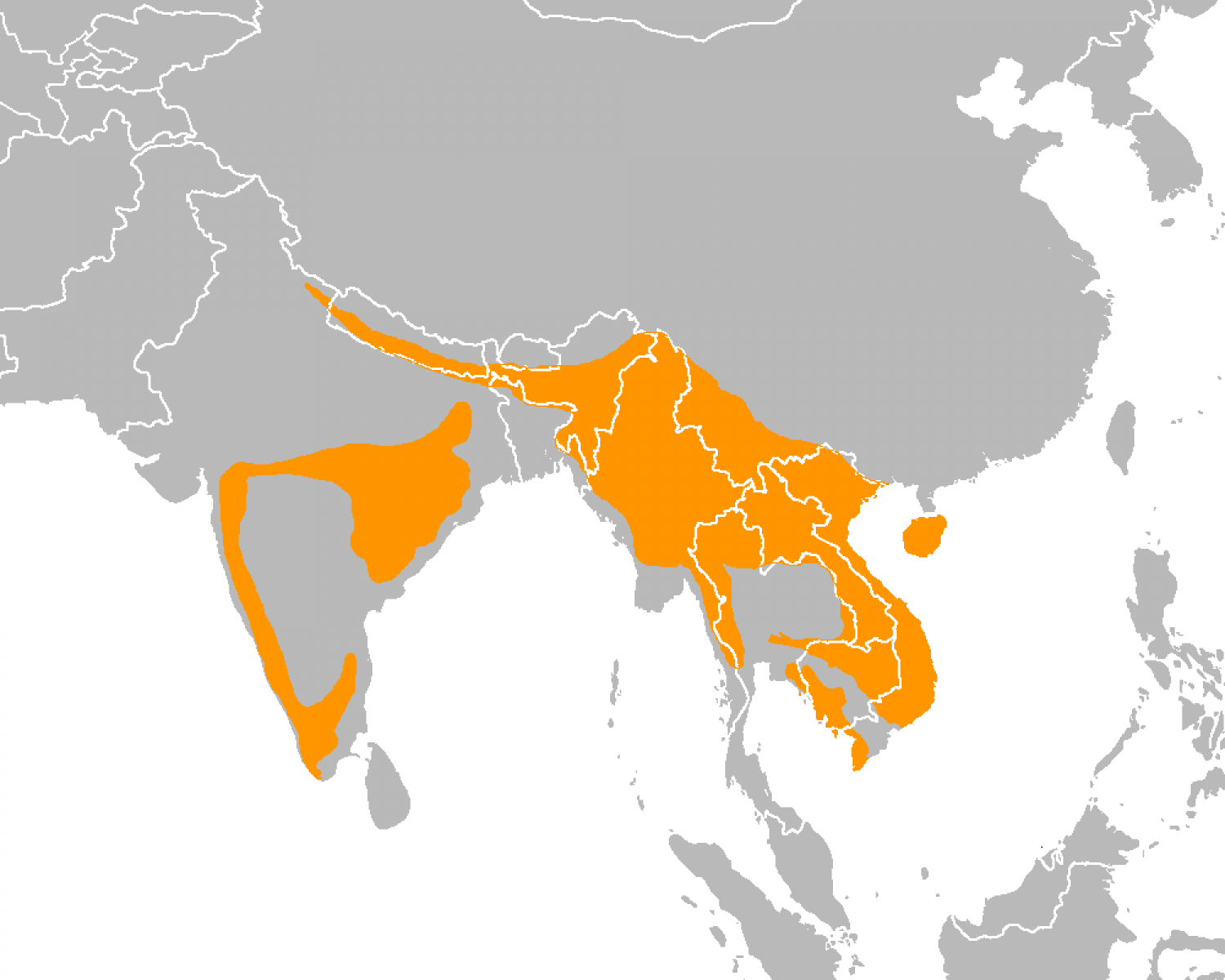Species of Thailand
Blue-bearded bee-eater
Nyctyornis athertoni
William Jardine & Prideaux John Selby, 1830
In Thai: นกจาบคาเคราน้ำเงิน
The blue-bearded bee-eater (Nyctyornis athertoni) is a species of bee-eater found in much of the Indian subcontinent and parts of Southeast Asia. This bee-eater is found in forest clearings. It is found mainly in the Malayan region but extends west into peninsular India. The blue feathers of its throat are elongated and often fluffed giving it its name. They have a loud call but are not as gregarious or active as the smaller bee-eaters, and their square ended tail lacks the typical "wires" made up of the shafts of the longer central tail feathers in many species.
Description
This large bee-eater has a large sickle shaped bill and the square ended tail lacks the "wires" that are typical of smaller bee-eaters. The bird is grass green with a turquoise forehead, face and chin. The feathers of the throat are elongated giving it a bearded appearance when they are fluffed out. The belly is yellowish to olive with streaks of green or blue. The peninsular Indian populations are said to be paler green than the northeast Indian populations. Although males and females appear similar, the blue throat feathers of the male show higher ultraviolet reflectivity than those of the female.
The species is named after Lieut. John Atherton (13th Light Dragoons, died in 1827) a nephew of Mrs. P. J. Selby who obtained a specimen of the bird. Selby described the species in "Illustrations of Ornithology" published along with Sir William Jardine in 1828. Jardine and Selby described it in the Illustrations of Ornithology (Series 1, Volume 2 part 4, November 1828, plate 58) and the type locality (holotype is in the Selby Collection, UMZC, 25/Mer/7/b/2) was said to be Cachar District Assam by E. C. Stuart Baker but Sir N B Kinnear re-designated Bangalore as the type locality for the species based on the fact that Atherton was posted in Bangalore when he wrote to Selby and noted that he was helped by a French collector (thought to be Leschenault). However the species is rare in that region. Atherton informed Selby that the bird was very rare, found in the thickest jungles, feeding at night and noisy with "curr, curr" calls.
The nominate form is found in India and parts of mainland Southeast Asia while brevicaudatus is an insular population from Hainan. A subspecies bartletti from northeastern India described by W. N. Koelz is subsumed into the nominate population.
Distribution and habitat
This species is found in a variety of habitats mostly at medium altitudes but below 2000m altitude. Thin to fairly thick forest in medium elevations with clearings is the typical habitat. It is found singly or in small groups of up to three and is very patchily distributed. Their presence in an area can easily be missed. It has been reported from the hill regions of the Satpuras, Western Ghats, Eastern Ghats, Nilgiris, Chota Nagpur and from the Sub-Himalayan forests.
Behaviour and ecology
This bird has a loud call, but does not call frequently. It is also not as active as the smaller bee-eaters. The calls include cackling hornbill like calls, a dry "Kit-tik... Kit-tik" in a series or hollow nasal "kyao" calls. Pairs may engage in duets of cackling and rattling which ends in short purring notes. The flight is undulating and very barbet-like.
The breeding season is February to August in India and courtship involves ritual feeding, bowing and tail fanning. Nest excavation may begin a month before the laying of eggs. The nest is a deep tunnel in a mud bank within which four very spherical and white eggs are laid.
The species appears to feed mainly on bees. It exploits the defensive behavior of Giant honey bee (Apis dorsata) colonies by provoking the mass release of guard bees which are then caught and eaten as they pursue the bird. Although mainly foraging using aerial sallies, it is known to glean from bark. They may sometimes associate with mixed-species foraging flocks. Birds have been seen at flowers of Erythrina and Salmalia although it is unclear whether they fed on nectar or insects attracted to the flowers.
A blood parasite Leucocytozoon nyctyornis has been described from this species and feather parasites Brueelia are also known.
This article uses material from Wikipedia released under the Creative Commons Attribution-Share-Alike Licence 3.0. Eventual photos shown in this page may or may not be from Wikipedia, please see the license details for photos in photo by-lines.
Category / Seasonal Status
BCST Category: Recorded in an apparently wild state within the last 50 years
BCST Seasonal status: Resident or presumed resident
Scientific classification
- Kingdom
- Animalia
- Phylum
- Chordata
- Class
- Aves
- Order
- Coraciiformes
- Family
- Meropidae
- Genus
- Nyctyornis
- Species
- Nyctyornis athertoni
Common names
- Thai: นกจาบคาเคราน้ำเงิน
Synonyms
- Alcemerops athertoni
- Merops athertoni
Conservation status

Least Concern (IUCN3.1)
Photos
Please help us review the bird photos if wrong ones are used. We can be reached via our contact us page.
Range Map

- Chae Son National Park
- Chaloem Rattanakosin National Park
- Chiang Dao District, Chiang Mai
- Chiang Dao Wildlife Sanctuary
- Chiang Saen District, Chiang Rai
- Doi Chong National Park
- Doi Inthanon National Park
- Doi Lang
- Doi Pha Hom Pok National Park
- Doi Phu Kha National Park
- Doi Suthep - Pui National Park
- Erawan National Park
- Fang District, Chiang Mai
- Hang Chat District, Lampang
- Huai Kha Khaeng Wildlife Sanctuary
- Huai Nam Dang National Park
- Huai Yang Waterfall National Park
- Kaeng Khoi District, Saraburi
- Kaeng Krachan District, Phetchaburi
- Kaeng Krachan National Park
- Khao Ang Rue Nai Wildlife Sanctuary
- Khao Khiao - Khao Chomphu Wildlife Sanctuary
- Khao Laem National Park
- Khao Soi Dao Wildlife Sanctuary
- Khao Yai National Park
- Khlong Kaeo Waterfall National Park
- Khon San District, Chaiyaphum
- Khun Chae National Park
- Khun Nan National Park
- Kui Buri National Park
- Mae Fa Luang District, Chiang Rai
- Mae Moei National Park
- Mae Ping National Park
- Mae Rim District, Chiang Mai
- Mae Taeng District, Chiang Mai
- Mae Wong National Park
- Muak Lek District, Saraburi
- Mueang Chiang Mai District, Chiang Mai
- Mueang Sa Kaeo District, Sa Kaeo
- Nam Nao National Park
- Non Din Daeng District, Buriram
- Nong Bong Khai Non-Hunting Area
- Omkoi Wildlife Sanctuary
- Pa Sang District, Lamphun
- Pachee River Wildlife Sanctuary
- Pai District, Mae Hong Son
- Pang Sida National Park
- Pha Daeng National Park
- Phu Hin Rong Kla National Park
- Phu Khiao Wildlife Sanctuary
- Phu Luang Wildlife Sanctuary
- Phu Suan Sai National Park
- Phu Toei National Park
- Sai Yok District, Kanchanaburi
- Sakaerat Environmental Research Station
- Si Racha District, Chonburi
- Sri Nakarin Dam National Park
- Taksin Maharat National Park
- Tat Mok National Park
- Thap Lan National Park
- Thong Pha Phum District, Kanchanaburi
- Thung Salaeng Luang National Park
- Thung Yai Naresuan Wildlife Sanctuary
- Umphang Wildlife Sanctuary



